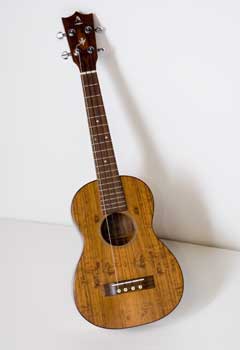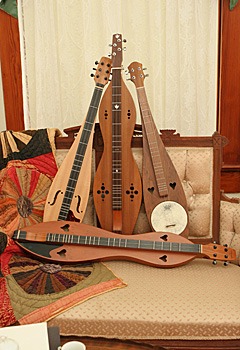Instruments
Anyone can be a musician!
Music is not only for a few 'gifted' souls, but for all who find joy in it.
- Deb Porter
I'd like to introduce you to two extremely user-friendly instruments, the ukulele and the fretted (mountain) dulcimer. I believe anyone can play either of these instruments. I've taught kids, old folks, people with disabilities, and people who have never picked up an instrument — all are filled with joy when they discover that they too are a musician. Don't believe me? Want to give it a try? Please take a look at one of my educational videos.
Ukulele

Deb's first ukulele, made out of walnut, is tuned to G-C-E-A with a "dropped-G" wound string tuned one octave down.
A ukulele, or uke, is a fretted string instrument which is essentially a smaller, four-stringed version of a guitar.
Historians agree that the birth of the ukulele occurred in 1879, when Portuguese agricultural workers arrived in Honolulu aboard the English ship Ravenscrag. Most of the men simply provided labor for the sugar plantations, however a few like Augusto Dias, Manuel Nunes, and Jose do Joao Santo also brought with them a remarkable musical ability and an intense passion and tradition for wood working. These men used their craftsmanship and skill to work with the Hawaiians to evolve the machete (a small guitar-like instrument with four cat-gut strings) into the ukulele.
During subsequent years, the island's population quickly embraced the ukulele and continued its development. While its rhythmic nature lent itself well to the accompaniment of the voice, one of its greatest attributes was the propulsive drive it contributed to the assemblage of Hawaiian dance bands. The ukulele was popularized in the continental United States between 1910 and 1915, when its Hawaiian players introduced the ukulele through Broadway musicals like "Bird of Paradise" and at the Panama Pacific International Exposition held in San Francisco.
Deb's Ukuleles
I play two tenor ukuleles, both built in Heidelberg, Mississippi by Fred Alsworth. My first uke is made out of walnut, and is tuned to G-C-E-A with a "dropped-G" wound string tuned one octave down. The second is built from a beautiful light curly maple. Both ukuleles have my signature descending dove inlayed into their headstock and fretboard. I also have a third ukulele, a 1950 Dixie Banjo-Uke, which is chrome-plated with an all metal neck and rim and tuned to G-C-E-A.
Fretted (Mountain) Dulcimer

Four dulcimers arranged on an antique sofa.
The dulcet tones and harmonious drones of the fretted dulcimer (also known as the mountain or Appalachian dulcimer) have been an important part of American music for over three hundred years. It is classified as a diatonically fretted "zither" – a "zither" being an instrument with strings stretched across a box from end to end and having no neck as do guitars and violins. Autoharps and hammered dulcimers are also zithers. "Diatonic" means that the instrument plays the eight tones of the major scale: do, re, mi, fa, so, la, ti, do like the white keys of the piano. Though it does not contain all the "chromatic" notes of the twelve tone scale found on pianos and guitars, it can be tuned to harmonize with nearly all Western folk music.
The earliest depiction of this type of instrument is found in a fresco from 1560 in the Church of Rynkeby on the Danish island of Fyn. An angel musician is seen plucking the strings of straight sided zither with her fingers. This beam like form spread throughout northern Europe and it is the Germanic variant called a "Scheitholt" that arrived in America probably in the early eighteenth century. These instruments have two sets of strings — one set to play the melody and the other to provide a continuous drone like a bagpipe. They generally had from eight to ten strings and were either plucked or played with a bow. This type of instrument was common over much of Europe with the exception of the British Isles.
The Appalachian dulcimer was forged in the melting pot of the wagon roads and river routes of the frontier. The Scots and Irish settlers could hear the drone of the pipes in this sturdy and easily constructed zither and the English found it to be an appropriate accompaniment to their ballads and laments. They reduced the number of strings to just three or four, as wire was a precious commodity in the wilderness, and added a raised fingerboard to allow the playing of quick jigs and reels with a plectrum. By reducing the strings the instrument became more adaptable to more types of music within this theater. Unlike other instruments that have a distinct evolution to their present form, the dulcimer is still being reinvented all the time. The shapes and sounds vary widely throughout the region. The Shenandoah Valley has a tradition of teardrop or boat shaped dulcimers played with a turkey quill for a pick. Kentucky is known for its delicate hourglass shaped three string instrument, and Tennessee is home to a large rectangular dulcimer that was known as a "music box". West Virginia, with its early German settlers and isolated regions has the most widely variegated traditions. There is also much cross-pollination, with North Carolina dulcimers sharing distinct West Virginia shapes and fretting ideas.
Most of the dulcimers of hundreds years ago were made of poplar which was readily available, easy to work, and not subject to warping with temperature and humidity extremes. Some few were made of walnut, cherry and maple. These woods have been most common in the twentieth century. Though there are a few examples of commercial makers in the late nineteenth century, for the most part dulcimers were made by individuals supplying their families and close neighbors. The settlement schools and folk revivals of the 1930s and 40s kept the dulcimer visible until Jean Ritchie left Viper, Kentucky in the fifties and brought the dulcimer to the world stage with her music and literature. Since the sixties, the Appalachian dulcimer has staked a claim in the American orchestra of rock, pop, jazz, country, blues and classical and is now more popular than ever. Its sweet voice will be heard for centuries to come because it's the sound of the ground we walk on.
— Excerpted from A Brief History of the Appalachian Dulcimer![]() by David Schnaufer.
by David Schnaufer.
Deb's Dulcimers
Primarily I play a C-G-C tuned Schnaufer Model McSpadden dulcimer, made from redwood with an ebony fretboard and an innovative pickguard. In addition, I play a Schnaufer Model 6-String tuned to D-A-D. This six string dulcimer is rooted in the 18th and 19th century scheitholt traditions and is sometimes referred to as a "church dulcimer", in part because the unamplified volume could fill a small church. Its bass string has a high D double, which gives it a rich full sound much like a 12-string guitar.
Janita Baker and Blue Lion Instruments designed my bass and baritone dulcimers. I tune my bass dulcimer, which has subsequently been converted to a baritone, to A-E-A. Janita customized this dulcimer by inlaying my signature descending dove into its headstock and fretboard.
